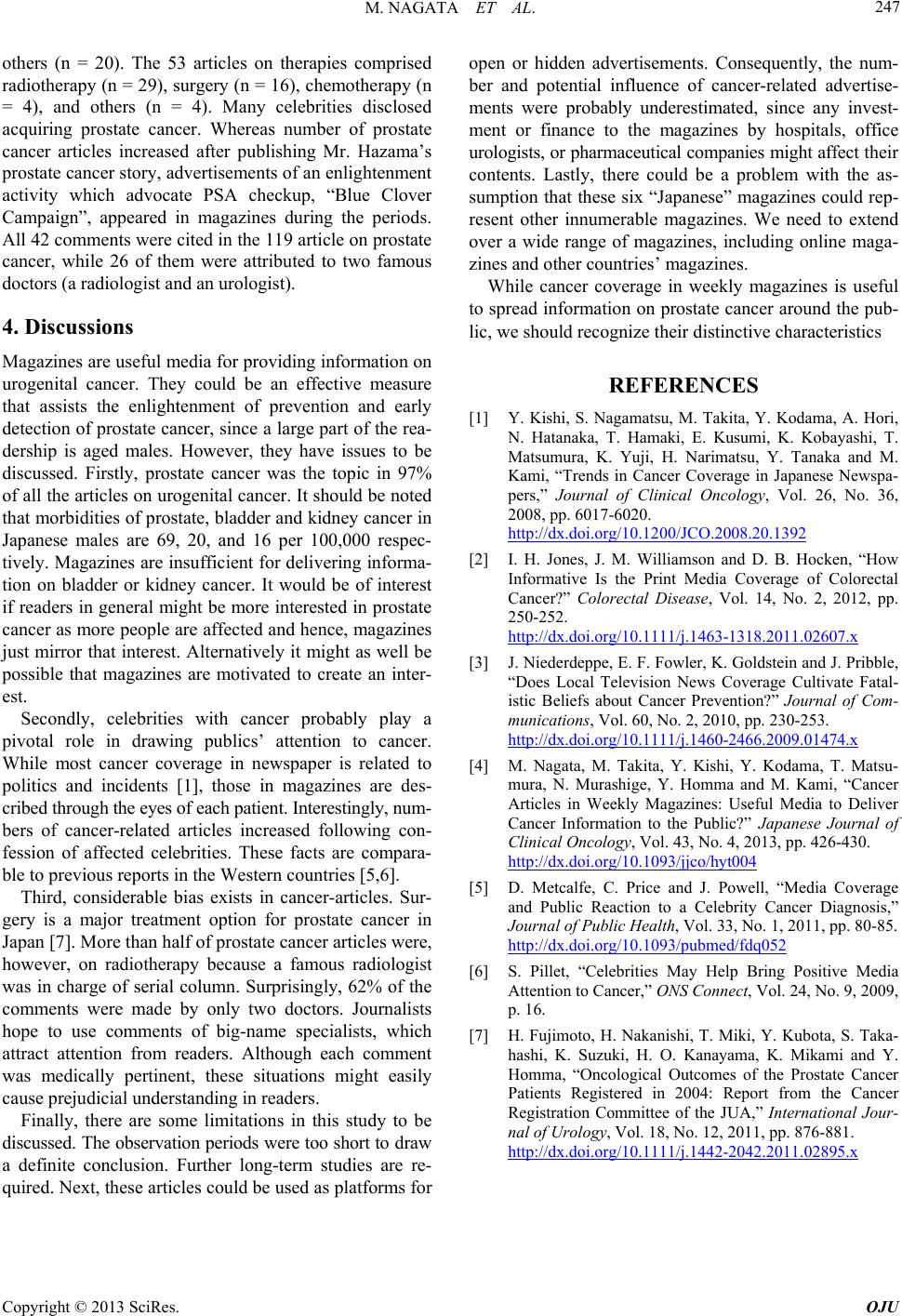
M. NAGATA ET AL. 247
others (n = 20). The 53 articles on therapies comprised
radiotherapy (n = 29), surgery (n = 16), chemotherapy (n
= 4), and others (n = 4). Many celebrities disclosed
acquiring prostate cancer. Whereas number of prostate
cancer articles increased after publishing Mr. Hazama’s
prostate cancer story, advertisements of an enlightenment
activity which advocate PSA checkup, “Blue Clover
Campaign”, appeared in magazines during the periods.
All 42 comments were cited in the 119 article on prostate
cancer, while 26 of them were attributed to two famous
doctors (a radiologist and an urologist).
4. Discussions
Magazines are useful media for providing information on
urogenital cancer. They could be an effective measure
that assists the enlightenment of prevention and early
detection of prostate cancer, since a large part of the rea-
dership is aged males. However, they have issues to be
discussed. Firstly, prostate cancer was the topic in 97%
of all the articles on urogenital cancer. It should be noted
that morbidities of prostate, bladder and kidney cancer in
Japanese males are 69, 20, and 16 per 100,000 respec-
tively. Magazines are insuffic ient for delivering informa-
tion on bladder or kidney cancer. It would be of interest
if readers in general might be more interested in prostate
cancer as more people are affected and hence, magazines
just mirror that interest. Alternatively it might as well be
possible that magazines are motivated to create an inter-
est.
Secondly, celebrities with cancer probably play a
pivotal role in drawing publics’ attention to cancer.
While most cancer coverage in newspaper is related to
politics and incidents [1], those in magazines are des-
cribed through the eyes of each patient. Interestingly, num-
bers of cancer-related articles increased following con-
fession of affected celebrities. These facts are compara-
ble to previous reports in the Western countries [5,6].
Third, considerable bias exists in cancer-articles. Sur-
gery is a major treatment option for prostate cancer in
Japan [7]. More than half of prostate can cer articles were,
however, on radiotherapy because a famous radiologist
was in charge of serial column. Surprisingly, 62% of the
comments were made by only two doctors. Journalists
hope to use comments of big-name specialists, which
attract attention from readers. Although each comment
was medically pertinent, these situations might easily
cause prejudicial understanding in readers.
Finally, there are some limitations in this study to be
discussed. The observation periods were too short to dr aw
a definite conclusion. Further long-term studies are re-
quired. Next, these articles could be used as platforms for
open or hidden advertisements. Consequently, the num-
ber and potential influence of cancer-related advertise-
ments were probably underestimated, since any invest-
ment or finance to the magazines by hospitals, office
urologists, or pharmaceutical companies might affect th eir
contents. Lastly, there could be a problem with the as-
sumption that these six “Japanese” magazines could rep-
resent other innumerable magazines. We need to extend
over a wide range of magazines, including online maga-
zines and other countries’ magazines.
While cancer coverage in weekly magazines is useful
to spread information on prostate cancer around the pub-
lic, we should recognize their distinctive characteristics
REFERENCES
[1] Y. Kishi, S. Nagamatsu, M. Takita, Y. Kodama, A. Hori,
N. Hatanaka, T. Hamaki, E. Kusumi, K. Kobayashi, T.
Matsumura, K. Yuji, H. Narimatsu, Y. Tanaka and M.
Kami, “Trends in Cancer Coverage in Japanese Newspa-
pers,” Journal of Clinical Oncology, Vol. 26, No. 36,
2008, pp. 6017-6020.
http://dx.doi.org/10.1200/JCO.2008.20.1392
[2] I. H. Jones, J. M. Williamson and D. B. Hocken, “How
Informative Is the Print Media Coverage of Colorectal
Cancer?” Colorectal Disease, Vol. 14, No. 2, 2012, pp.
250-252.
http://dx.doi.org/10.1111/j.1463-1318.2011.02607.x
[3] J. Niederdeppe, E. F. Fowler, K. Goldstein and J. Pribble,
“Does Local Television News Coverage Cultivate Fatal-
istic Beliefs about Cancer Prevention?” Journal of Com-
munications, Vol. 60, No. 2, 2010, pp. 230-253.
http://dx.doi.org/10.1111/j.1460-2466.2009.01474.x
[4] M. Nagata, M. Takita, Y. Kishi, Y. Kodama, T. Matsu-
mura, N. Murashige, Y. Homma and M. Kami, “Cancer
Articles in Weekly Magazines: Useful Media to Deliver
Cancer Information to the Public?” Japanese Journal of
Clinical Oncology, Vol. 43, No. 4, 2013, pp. 426-430.
http://dx.doi.org/10.1093/jjco/hyt004
[5] D. Metcalfe, C. Price and J. Powell, “Media Coverage
and Public Reaction to a Celebrity Cancer Diagnosis,”
Journal of Public Health, Vol. 33, No. 1, 2011, pp. 80-85.
http://dx.doi.org/10.1093/pubmed/fdq052
[6] S. Pillet, “Celebrities May Help Bring Positive Media
Attention to Cancer,” ONS Connect, Vol. 24, No. 9, 2009,
p. 16.
[7] H. Fujimoto, H. Nakanishi, T. Miki, Y. Kubota, S. Taka-
hashi, K. Suzuki, H. O. Kanayama, K. Mikami and Y.
Homma, “Oncological Outcomes of the Prostate Cancer
Patients Registered in 2004: Report from the Cancer
Registration Committee of the JUA,” International Jour-
nal of Urology, Vol. 18, No. 12, 2011, pp. 876-881.
http://dx.doi.org/10.1111/j.1442-2042.2011.02895.x
Copyright © 2013 SciRes. OJU